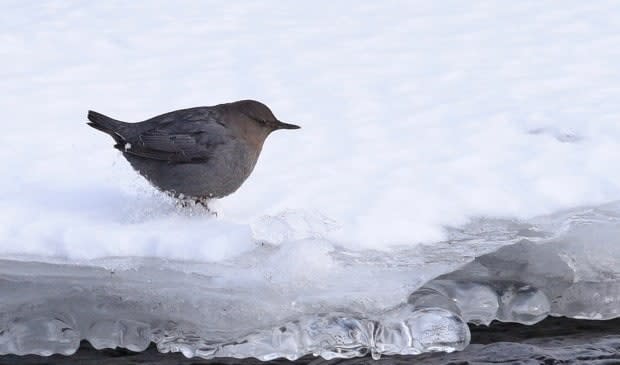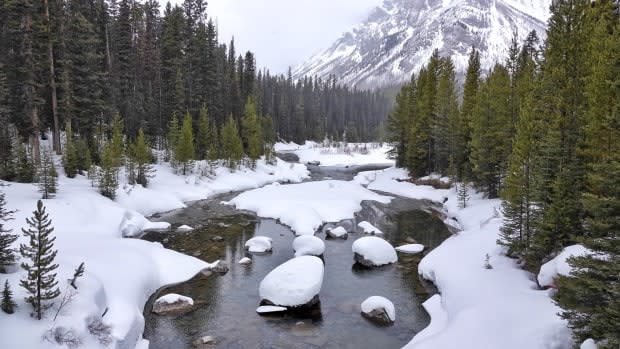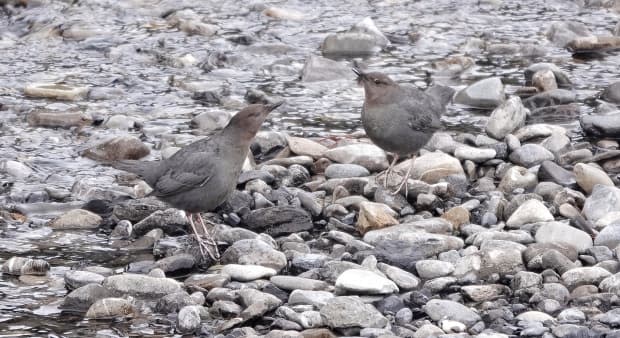These birds are known to 'walk underwater' and are perfectly fine with icy cold streams

You may have heard of birds swimming underwater — but how about walking?
Well, naturalist Brian Keating says that's precisely what the American dipper — otherwise known as the water ouzel — does on a regular basis.
On a recent backcountry cross-country skiing trip, Keating and his wife spotted four dippers in two different locations after being alerted to their presence by their distinctive song.
"We were at about 1,800 metres above sea level, so about 6,000 feet," Keating told The Homestretch. "And yes, they were dipping, as dippers do.
"In fact, an excited dipper will dip 50 times a minute … they do it for a living."
Keating said the dipper is the size of a plump robin with its tail cut short and can look almost like a grey tennis ball.
The birds are slate grey and blend perfectly into a cobblestone creek if they are standing motionless.
"That's where you find them, mountain creeks and streams, all the way up to about three or three and a half thousand metres above sea level," he said. "That's their habitat — fast, flowing, clear, clean creeks and streams."

Keating said the birds communicate by blinking rapidly to expose a flash of white feathers on their upper eyelids, which is a form of expression in courtship and threat displays.
The bobbing is a visual communication, Keating said, citing one study done on spotted sandpipers which have a habit of bobbing their tails up and down.
"It indicated that the louder the whitewater noise, the greater the intensity and frequency of the tail going up and down," he said.
"Now I don't know if that's the case with dippers, but I suspect it is — it's basically a way of communicating when there's a lot of loud whitewater noise behind you."
Unique qualities
Dippers eat a lot of small prey — mostly invertebrates and small crustaceans, and will also take small fish and fish eggs.
But the birds' unique qualities make them especially well-suited for their environment. Take how they use their eyes underwater, for instance.
"They've got well-developed focal muscles in their eyes that can change the curvature of the lens to allow them to see underwater," Keating said.
"They've got nictitating membrane too, so it's a third eyelid that covers the eye, protects the eye, when they go [underwater]."
Dippers have nasal flaps to prevent water from entering their noses when they're under the water. When they're under the water and walking on the bottom of the creek, they turn over stones and other river debris to look for food.
"They will sometimes perch on the rocks and just feed off the edge of the rock. They often grip the rocks firmly and then they walk down into the fast-flowing water, and they disappear completely," Keating said.
"They sometimes use their wings to swim, but they can walk underwater with strong claws. They can go down as deep as six metres, which is crazy."

Dippers have a large preen gland, which they use to waterproof their feathers. They've also got a very high hemoglobin count in their blood, which allows them to store a greater amount of oxygen.
"They've been recorded to stay under the water for 30 seconds or more, which is a pretty long time for a tiny little bird," Keating said.
Add in a very low basal metabolic rate — about a third slower than a typical comparable terrestrial bird — and dippers are also equipped to conserve energy in cold mountain creeks.
"It's amazing to see these birds in the winter or the summer," Keating said. "But in the winter, seeing them go in and out of the icy cold water — it's just ridiculous."
For more fascinating stories about Alberta's wildlife from naturalist Brian Keating, visit his website and check out these stories:
With files from The Homestretch.

 Yahoo Movies
Yahoo Movies 